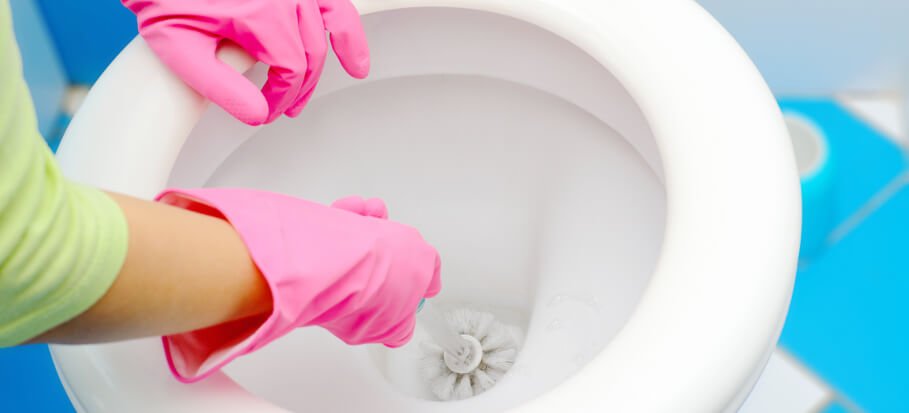How to Get Rid of Black Stains in Your Toilet Bowl: Causes, Effective Solutions, Costs, and Prevention Tips for a Spotless Bathroom
Black stains in the toilet bowl can be an unsightly and frustrating problem for homeowners. These stains not only make your bathroom look dirty, but they can also be stubborn and difficult to remove. In most cases, black stains are caused by a build-up of minerals, mold, or mildew, which thrive in the moist, damp environment of your toilet. This article will explore how to get rid of black stains in the toilet bowl by answering common questions about what causes them, the best methods for removal, costs, and tips for preventing future stains. With practical solutions and expert advice, you’ll be able to maintain a sparkling, stain-free toilet.

1. What Causes Black Stains in the Toilet Bowl?
Understanding the cause of black stains in your toilet bowl is the first step to effectively removing them. These stains can develop for a variety of reasons:
a. Mineral Deposits
Hard water can lead to mineral buildup over time, especially if your home has high levels of iron, manganese, or calcium in its water supply. These minerals can oxidize and form black stains in your toilet bowl. According to the U.S. Geological Survey, approximately 85% of U.S. homes have hard water, making this a common cause of stains.
b. Mold and Mildew
Bathrooms are typically warm, humid environments, making them prime breeding grounds for mold and mildew. If your toilet isn’t cleaned regularly or has poor ventilation, mold and mildew can grow in areas like the waterline or under the rim, resulting in black streaks or spots.
c. Bacteria Build-Up
Bacterial growth, especially iron-related bacteria, can lead to black or rust-colored stains. These bacteria feed on iron and manganese, commonly found in well water, creating a slimy, dark residue in your toilet bowl.
d. Water Quality
Poor water quality, including high levels of sulfur, can also contribute to black staining in toilets. Water with sulfur can produce a black or dark stain, often accompanied by a foul odor.
2. How to Get Rid of Black Stains in the Toilet Bowl?
Once you’ve identified the potential cause of the stains, you can take targeted action. Here’s how to remove black stains based on different sources:
a. Removing Mineral Deposits
- White Vinegar and Baking Soda: This classic combination works effectively to break down mineral deposits. Pour a cup of white vinegar into the toilet bowl and let it sit for 10-15 minutes. Sprinkle baking soda into the bowl and scrub with a toilet brush.
- Pumice Stone: For tougher mineral stains, a pumice stone can be used to scrub away the buildup. Make sure to wet the stone to avoid scratching the porcelain.
- Commercial Descalers: Products like Lime-A-Way or CLR (Calcium, Lime, and Rust Remover) are designed to dissolve mineral deposits. Follow the manufacturer’s instructions and use gloves when applying these chemicals.
b. Eliminating Mold and Mildew
- Bleach: Regular household bleach is highly effective against mold and mildew. Pour about half a cup of bleach into the toilet bowl, let it sit for 30 minutes, then scrub with a brush. Make sure to flush the toilet afterward.
- Hydrogen Peroxide: An eco-friendlier alternative to bleach, hydrogen peroxide can be used to kill mold and mildew. Pour a cup into the bowl and let it sit for an hour before scrubbing.
- Tea Tree Oil: Tea tree oil is a natural antifungal agent. Add 10-15 drops to the water in your toilet bowl, let it sit for several hours or overnight, and scrub the stains away.
c. Removing Bacteria-Related Stains
- Vinegar and Borax: Vinegar’s acidic properties and borax’s cleaning power make a great combination for tackling bacteria-related stains. Sprinkle borax in the toilet bowl, pour vinegar over it, and let the mixture sit for 30 minutes before scrubbing.
- Disinfectant Toilet Tablets: Placing disinfectant tablets that release chlorine or other cleaning agents with each flush can help prevent the recurrence of bacterial stains.
3. How Much Does It Cost to Remove Black Stains from the Toilet Bowl?
The cost of removing black stains can vary depending on whether you choose to use DIY methods or professional services. Here’s an estimate of the expenses involved:
a. DIY Cleaning Supplies
- White Vinegar: $2 to $5 per gallon.
- Baking Soda: $1 to $3 per box.
- Bleach: $3 to $6 per bottle.
- Hydrogen Peroxide: $1 to $4 per bottle.
- Pumice Stone: $5 to $10.
- Commercial Descalers: $10 to $15 per bottle.
- Tea Tree Oil: $8 to $15 for a small bottle.
Overall, for DIY cleaning supplies, you can expect to spend between $10 and $25, depending on the methods you choose.
b. Hiring Professional Cleaners
If the stains are persistent or you’re dealing with a large-scale issue (like mold), you may want to consider hiring a professional cleaning service. Prices for professional bathroom cleaning services typically range from $50 to $150 per visit, depending on the level of cleaning required and your location.
4. Where Are Black Stains Most Commonly Found in the Toilet?

Black stains tend to appear in specific areas of the toilet bowl due to where mold, minerals, and bacteria are most likely to accumulate. These areas include:
- Around the Waterline: The waterline is a common spot for stains because minerals and bacteria settle and oxidize where the water sits.
- Under the Rim: Mold and mildew can thrive under the toilet rim, where it’s dark and often damp. This area is hard to reach and is often neglected during cleaning.
- At the Bottom of the Bowl: Mineral deposits and bacteria can accumulate at the bottom of the toilet, where the water drains after each flush. These areas are prone to dark staining if not cleaned regularly.
5. Why Is It Important to Clean Black Stains Regularly?
Maintaining a clean toilet bowl is essential for several reasons:
a. Hygiene and Health
Mold, mildew, and bacteria can pose health risks, especially for individuals with allergies, asthma, or weakened immune systems. Cleaning black stains regularly prevents the growth of these harmful organisms and ensures a sanitary bathroom environment.
b. Aesthetics
A stained toilet bowl looks dirty and uninviting, even if the rest of the bathroom is clean. Regular cleaning helps maintain the overall appearance of your bathroom and ensures that it looks fresh and welcoming to guests.
c. Preventing Damage
Mineral deposits can harden over time and cause long-term damage to the porcelain surface of your toilet. Over time, untreated black stains can become more difficult to remove and may even lead to permanent discoloration.
6. How Can You Prevent Black Stains in the Toilet Bowl?

While cleaning is important, preventing black stains from forming in the first place is the best way to maintain a spotless toilet. Here are some effective prevention tips:
a. Regular Cleaning
Cleaning your toilet at least once a week can prevent the buildup of minerals, mold, and bacteria. Use a toilet bowl cleaner or a mixture of vinegar and baking soda to scrub the bowl and under the rim.
b. Install a Water Softener
If hard water is a problem in your home, consider installing a water softener. These systems help reduce the amount of minerals (like calcium and magnesium) in your water, preventing the formation of hard water stains.
c. Improve Ventilation
Mold and mildew thrive in damp, poorly ventilated environments. Ensure that your bathroom is well-ventilated by using an exhaust fan or opening a window to reduce moisture buildup.
d. Use Automatic Toilet Cleaners
Placing an automatic toilet cleaner in your tank can help keep your toilet clean between deep cleanings. These cleaners release small amounts of cleaning agents with each flush to prevent the buildup of stains.
e. Flush Regularly
Stains can build up faster in toilets that are not used or flushed regularly. Make it a habit to flush your toilet even if it hasn’t been used recently to reduce the chances of bacteria and mineral buildup.
7. How Do You Deal with Stubborn or Persistent Stains?
If black stains persist despite regular cleaning, it may be time to take more aggressive action. Here’s how you can deal with the most stubborn stains:
a. Increase the Strength of Cleaners
Switch to a stronger commercial cleaner if natural solutions aren’t effective. Products like toilet bowl cleaners with bleach or strong acid-based cleaners may be necessary for tough stains.
b. Soak Overnight
For mineral deposits, soaking the stains overnight with a cleaner like white vinegar, bleach, or a commercial descaler can soften the buildup, making it easier to scrub away in the morning.
c. Consider Replacing the Toilet
In some cases, especially with older toilets, stains may have penetrated the surface of the porcelain, making them impossible to remove entirely. If your toilet is old or heavily stained, replacing it with a new one may be the most effective solution.
Conclusion
Getting rid of black stains in your toilet bowl can be a challenge, but with the right methods and preventive measures, you can maintain a clean, stain-free bathroom. By understanding what causes black stains—whether it’s mineral deposits, mold, or bacteria—you can choose the most effective solution and keep your toilet in pristine condition. Regular cleaning, using the right cleaning agents, and implementing preventive strategies will ensure that your bathroom remains hygienic and welcoming for you and your guests.
Whether you’re dealing with minor stains or persistent black streaks, the information in this article will help you tackle the problem effectively. Now that you know how to get rid of black stains in the toilet bowl, you can enjoy a cleaner, more inviting bathroom year-round.





